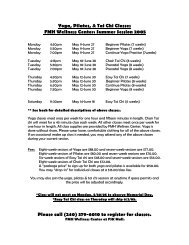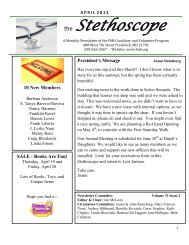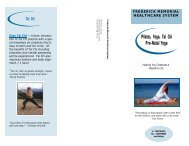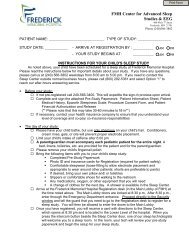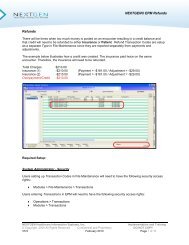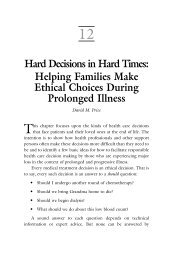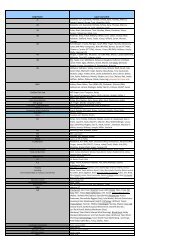In-Toeing / Out-Toeing
In-Toeing / Out-Toeing
In-Toeing / Out-Toeing
Create successful ePaper yourself
Turn your PDF publications into a flip-book with our unique Google optimized e-Paper software.
MARYLAND PEDIATRIC ORTHOPAEDIC CENTER, L.L.C.<br />
Phone (301) 829‐2552 Fax (301) 829‐9588<br />
Mt. Airy Office Mt. Washington Pediatric Hospital<br />
1502 South Main Street #307 1708 W. Rogers Avenue<br />
Mt. Airy, MD 21771 Baltimore, MD 21209<br />
<strong>In</strong>‐<strong>Toeing</strong> / <strong>Out</strong>‐<strong>Toeing</strong><br />
Andrew J. Abramowitz, M.D.<br />
<strong>In</strong>-toeing and out-toeing are frequent causes for visits to the pediatric orthopedist<br />
for infants and children. Rotation of the legs cause a wide range of normal<br />
variations in children’s feet so that most cases of excessive in-toeing or out-toeing<br />
are variations of normal in infants and children. These rotational variations are<br />
often a cause of concern for family members and occasionally cause minor<br />
difficulties for children. <strong>In</strong> order to be sure that the in-toeing or out-toeing is a part<br />
of normal development, the child must be evaluated thoroughly to establish a<br />
reason for the toes pointing in or out. A thorough history is taken to make sure<br />
that:<br />
there is no family history of hip or foot problems<br />
there were no problems with the pregnancy<br />
the child is developing normally, and<br />
there are no muscle problems or recent trauma.<br />
Occasionally, leg rotational problems can be a marker for an underlying medical<br />
disorder such as cerebral palsy, limb length differences, hip disorders, or<br />
angulations of the limb.<br />
The majority of children’s feet point straight ahead or slightly outward. Children<br />
whose feet point inward are said to be “in-toeing” or “pigeon toed”. <strong>In</strong> the vast<br />
majority of children, in-toeing will go away without any treatment. <strong>In</strong> the past,<br />
braces were used to treat in-toeing, but recent studies have shown that braces offer<br />
no advantages. The normal progression of rotational growth in the lower<br />
extremity leads to correction in most cases of in-toeing by age 6 to 8. <strong>In</strong> a small<br />
percentage of children, the in-toeing does not completely resolve; but most of these<br />
children will cope just fine without any difficulties in their activities of daily<br />
living. Rarely does a child with unresolved in-toeing need surgical treatment to<br />
correct the problem. There is no evidence that in-toeing leads to arthritis or causes<br />
clumsiness. <strong>In</strong> fact, many of our best track and field athletes are pigeon toed.<br />
Page 1 of 3
Occasionally, in-toeing may cause problems with shoe wear, but braces, special<br />
shoes, or inserts do not correct the problem.<br />
There are three causes for in-toeing:<br />
metatarsus adductus, the child’s feet bend inward from the middle part of<br />
the foot. This is typically caused by the position of the baby in the uterus.<br />
tibial torsion, the child’s lower leg twists out of normal alignment, and<br />
femoral ante version, the child’s thigh bone turns inward.<br />
The metatarsus adductus can be mild, moderate, or severe. <strong>In</strong> mild feet, the foot<br />
can be overcorrected passively. These feet usually resolve by the age of 2 years.<br />
<strong>In</strong> moderate feet, the foot can be passively corrected so that the lateral border is<br />
straight, but it cannot be overcorrected. These feet also usually improve on their<br />
own in the majority of cases, and occasionally may<br />
need special shoes to help obtain and maintain the<br />
correction. Both mild and moderate feet also respond<br />
well to stretching to help get the foot straighter. This<br />
is usually shown to the parents by the doctor and can<br />
be done at home at bath time. Stiff feet cannot be<br />
stretched so that the outside border of the foot is<br />
straight. These feet may be treated with a series of casts to help stretch the feet,<br />
followed by special shoes to maintain the correction. Rarely, surgery may be<br />
necessary if casting fails or if the deformity recurs during growth and the child has<br />
functional problems as a result.<br />
<strong>In</strong>ternal tibial torsion is an inward twist of the tibia bone. This<br />
is usually noticed when the child begins to walk. <strong>In</strong>ward<br />
twisting is normal in many babies and often corrects by the<br />
age of 1. However, the inward twist is slower to correct in<br />
some children and these are the ones that usually present to the<br />
doctor. <strong>In</strong> about 90% of patients the inward twist slowly<br />
corrects itself by about ages 4-6. As the child begins to walk<br />
with tibial torsion it frequently causes tripping and falls;<br />
however, as the child grows and muscles develop, they are<br />
better able to cope with the in-toeing until it ultimately<br />
resolves in most cases.<br />
Studies have shown that bracing does not speed up the<br />
correction of inward tibial torsion, so most doctors do not<br />
prescribe any treatment other than observation. <strong>In</strong> about 10% of patients the tibial<br />
torsion does not correct, but most children function perfectly well and there is no<br />
evidence that tibial torsion causes arthritis or functional problems in the long run.<br />
<strong>In</strong> the rare case that the torsion does not resolve by age 6 to 8 and the child does<br />
Page 2 of 3
have a functional problem as a result of the torsion, the treatment is to cut the bone<br />
and rotate it outward so the feet point straight. Very few children without<br />
neuromuscular problems need this surgery, therefore careful discussion with the<br />
doctor is necessary before pursuing surgery.<br />
Femoral anteversion, an excessive inward twist of the upper thigh bone at the hip<br />
region, is usually noticed between ages 2 to 4. All<br />
children are born with some inward twist of the thigh<br />
bone. As the children grow, the ligaments around the<br />
hip tighten causing the anteversion to resolve during<br />
the first few years of life. <strong>In</strong> some children, these<br />
ligaments never completely tighten up and when the<br />
child starts to walk they can become even looser,<br />
causing the hips to rotate further inward. This causes<br />
the in-toeing to be noticed between ages 2 and 4.<br />
Most cases of femoral anteversion resolve<br />
spontaneously by the time the child is between 6 and<br />
8 years old. Once again, it has been shown that<br />
special shoe wear and braces do not improve on the<br />
natural resolution of the deformity, and may actually cause problems such as<br />
discomfort and poor self esteem. A few children will not resolve their anteversion<br />
but most function fine without any problems. <strong>In</strong> the rare case that the anteversion<br />
does not resolve by age 6 to 8 and the child does have a functional problem as a<br />
result of the torsion, the treatment is to cut the bone and rotate it outward so the<br />
feet point straight.<br />
<strong>Out</strong>-toeing is much less common than in-toeing. The most typical presentation is<br />
within the first or second year of life. Most children are born with external rotation<br />
contractures of the hips and this resolves shortly after walking begins. <strong>In</strong> those<br />
children in whom the resolution is slower, out-toeing is the result when they first<br />
start walking. This will almost always resolve within a year from the onset of<br />
walking. <strong>Out</strong>-toeing may also be caused by outward twisting of the tibia or femur<br />
bone, and is not usually seen in normal children, but is more common in those with<br />
neuromuscular abnormalities. As with in-toeing, bracing and shoe wear are not<br />
helpful in resolving the deformity. Occasionally, a normal child will have outtoeing<br />
from tibial or femoral outward twisting that does not resolve by the end of<br />
the first decade. This may cause functional difficulties. If this is the case, surgery<br />
can be done to cut the bone and rotate to a more normal position. This is also<br />
rarely necessary.<br />
Page 3 of 3



